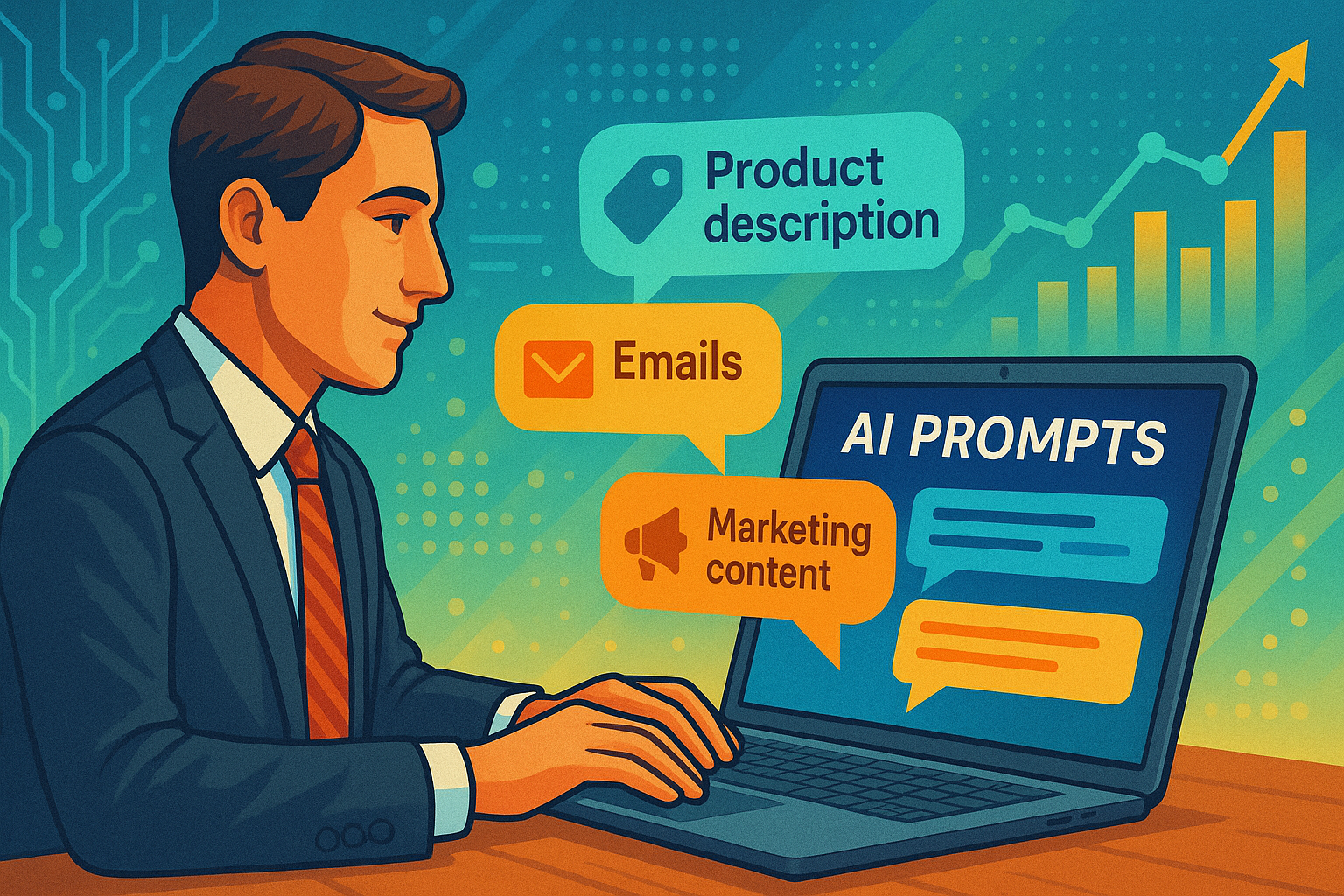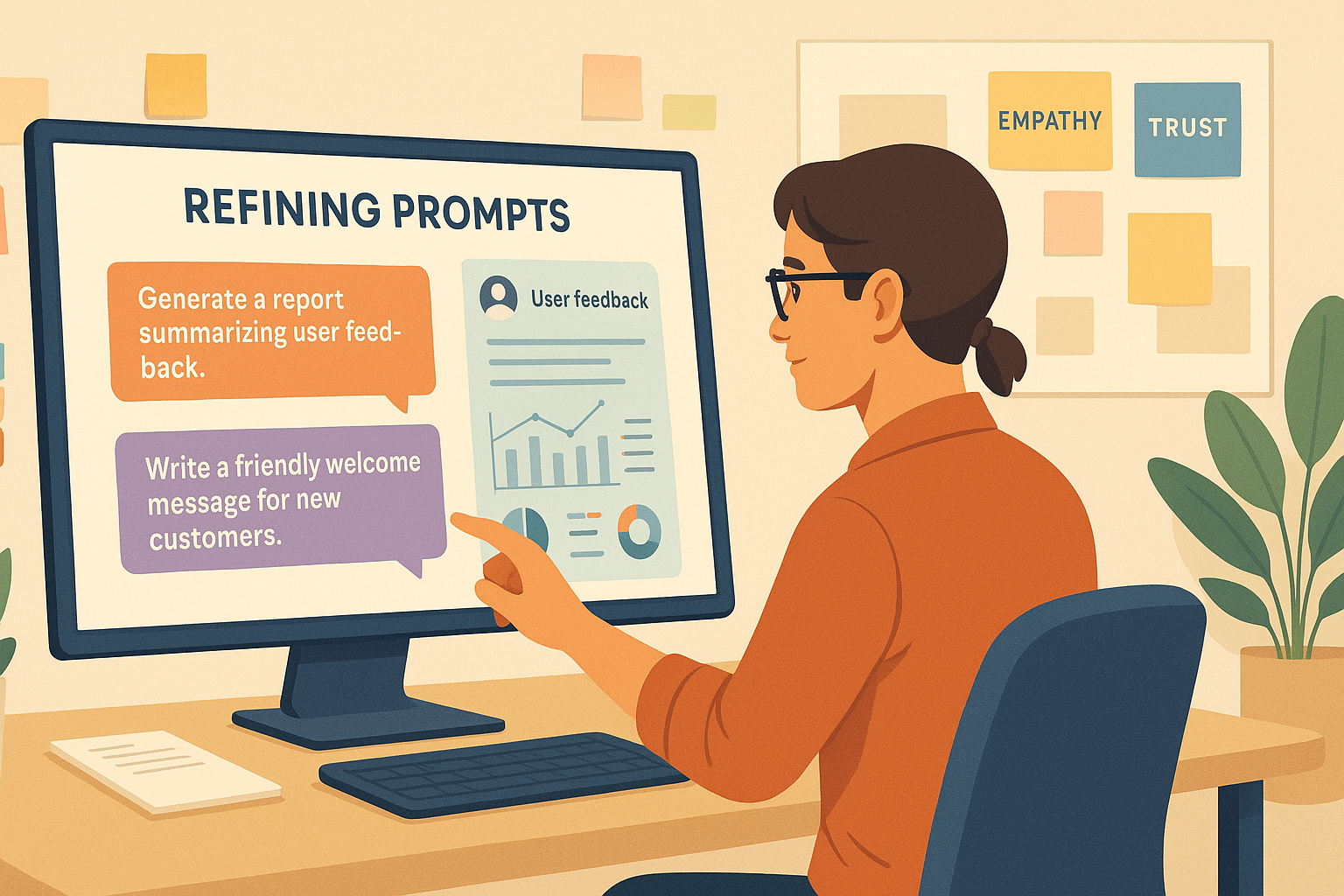The Power of Prompts: A Seller’s Guide to Unlocking AI for Business Success

Why Prompts Are Transforming the Selling Landscape
Artificial intelligence has become a game changer for modern businesses, but its true power is only unleashed when you know how to communicate with it effectively. Prompts—clear, well-crafted instructions—are the key to getting high-quality, relevant outputs from AI tools. For sellers, mastering prompts means unlocking faster content creation, sharper insights, and more engaging customer interactions. This guide will show you how to harness the power of prompts to elevate your sales and marketing efforts.
Understanding AI Prompts
What Is a Prompt?
A prompt is a specific input or instruction you give to an AI model to guide its response. In simple terms, it’s the question or statement that tells the AI what you need. Whether you want product descriptions, social media captions, or email drafts, the prompt shapes the output’s tone, style, and content.
How Prompts Drive AI Responses
AI models like ChatGPT or image generators use prompts to understand context and intent. The clearer and more detailed your prompt, the better the results. For example, asking “Write a product description” yields something generic, while “Write a persuasive, benefit-focused description of a waterproof hiking backpack for outdoor enthusiasts” produces richer, targeted content.
Examples of Effective Prompts in Business
Here are a few examples sellers use every day:
- Product Copy: “Create a short, friendly description highlighting the unique features of this handmade ceramic mug.”
- Email Drafts: “Write a warm follow-up email to a customer who inquired about shipping times.”
- Ad Headlines: “Generate five catchy headlines for a Facebook ad promoting summer skincare products.”
These examples show how specificity drives useful output.
The Psychology of Prompting
Clarity and Context in Communication
Effective prompting is rooted in the psychology of clear communication. Humans and machines alike respond better to unambiguous instructions. Providing context—like audience, tone, and purpose—makes it easier for AI to deliver exactly what you envision.
Guiding AI Behavior with Precision
Precision prompts help you control the style and detail of the content. For instance, specifying “Write in a conversational tone at a 6th-grade reading level” will produce language that’s approachable and easy to understand, perfect for broad consumer audiences.
Reducing Cognitive Load for Faster Results
Well-crafted prompts save time by reducing the need for extensive edits and revisions. Instead of sifting through vague or off-topic results, you can get closer to the final version in a single step. This efficiency is why prompt mastery is such a valuable skill for modern sellers.
Crafting High-Impact Prompts
The Elements of a Great Prompt
High-impact prompts share several essential traits:
- Specificity: Clear instructions that eliminate ambiguity
- Context: Details about the audience, purpose, and tone
- Format: Guidance on structure, such as bullet points or paragraphs
Combining these elements helps AI models understand exactly what you want.
Common Prompting Mistakes
Many sellers fall into traps that reduce output quality. The most common mistakes include:
- Vague or overly broad prompts
- Conflicting instructions (e.g., “Be brief but detailed”)
- Omitting the intended audience or style
Avoiding these missteps can save hours of editing and frustration.
Iteration and Refinement Techniques
Prompting is rarely a one-and-done process. The best results come from iterative refinement. Start with a draft prompt, review the AI output, and tweak your instructions to clarify expectations. Over time, you’ll develop a library of proven prompts tailored to your business needs.
Prompts for Product Descriptions
Turning Features into Benefits
Effective product descriptions don’t just list features—they explain why those features matter to the buyer. A strong prompt guides AI to frame benefits compellingly. For example:
“Write a 50-word description that explains how the ergonomic handle reduces wrist strain.”
Using Persuasive Language
Persuasion is essential in sales copy. Prompting the AI to use powerful action verbs and sensory language can make descriptions more enticing. Try prompts like:
“Describe this scented candle using vivid, sensory words that evoke relaxation.”
Maintaining Brand Voice Consistency
Consistency builds trust. Including brand voice guidelines in your prompts helps maintain a unified tone. For example:
“Write in a friendly, upbeat voice suitable for eco-conscious millennial shoppers.”
Prompts for Marketing and Social Media
Generating Ad Copy That Converts
Well-structured prompts can produce high-converting ad copy quickly. Be clear about the platform, audience, and desired call to action:
“Generate three Facebook ad headlines targeting young parents interested in educational toys.”
Creating Engaging Social Posts
AI can save time creating a steady stream of posts. Prompt examples:
“Write an Instagram caption promoting our new organic skincare line with an emoji and hashtag.”
Tailoring Messages for Different Platforms
Different platforms have unique styles and limits. Clarify this in your prompt:
“Write a short, professional LinkedIn update announcing our new B2B service.”
Prompts for Customer Engagement
Crafting FAQs and Knowledge Base Content
AI can help you build a comprehensive FAQ library to empower your customers. Use prompts like:
“Create five clear, friendly FAQs about our return policy for online shoppers.”
Providing the right context ensures the tone matches your brand and the answers are accurate.
Automating Personalized Email Responses
Personalized emails drive engagement and loyalty. You can prompt AI to draft tailored messages:
“Write a warm thank-you email to a customer who just purchased their third order.”
Include personalization details (like name, product, or order history) to improve relevance.
Improving Customer Support Chatbots
Chatbots rely heavily on prompts to deliver helpful responses. Sample prompt:
“Provide a concise answer to a customer asking if this product is vegan.”
Training your AI with clear, specific prompts improves customer satisfaction and reduces support costs.
Prompts for Sales Enablement
Preparing Sales Scripts and Objection Handling
AI can help sales teams respond confidently to objections and close deals faster. Example prompts:
“Create a script for handling price objections from small business customers.”
By anticipating challenges, your team is better equipped to build trust and overcome resistance.
Generating Proposals and Quotes
Prompting AI to draft proposals saves time while maintaining professionalism:
“Write a proposal outline for a custom software development project targeting a mid-sized logistics company.”
You can refine outputs to match your exact specifications and brand style.
Enhancing CRM Workflows
From follow-up reminders to personalized recommendations, prompts can automate CRM tasks. Try:
“Generate a follow-up email template for leads who haven’t responded in 10 days.”
This keeps your pipeline moving without manual effort.
Using Prompts for Competitive Analysis
Gathering Insights from Market Data
Prompts can direct AI to summarize research and spot trends:
“Summarize key trends in the home fitness market over the past year.”
These insights inform product development and positioning strategies.
Summarizing Competitor Content
Stay ahead by understanding your competitors’ messaging. Prompt examples:
“Analyze this competitor’s website and summarize their unique selling propositions.”
Clear instructions will yield concise, actionable summaries.
Predicting Trends with AI Models
AI can even help forecast industry shifts:
“Predict upcoming trends in sustainable packaging based on current data and reports.”
While predictions should be verified, they provide a valuable starting point for strategic planning.
Legal and Ethical Considerations
Ensuring Data Privacy Compliance
When using AI-generated content, sellers must protect customer data and comply with regulations like GDPR or CCPA. Make sure your prompts don’t include personally identifiable information unless you have explicit consent, and always verify outputs for compliance.
Avoiding Misleading Content
AI can produce plausible but inaccurate statements. To maintain trust, review outputs carefully before publishing and avoid prompts that might generate exaggerated or false claims. Transparency about AI-assisted content also helps build credibility with your audience.
Maintaining Transparency with AI-Generated Materials
Many consumers appreciate knowing when content is created by AI. Consider including disclaimers or labels when appropriate, especially in sensitive contexts like legal or health advice.
Prompt Templates and Frameworks
Plug-and-Play Prompts for Sellers
To speed up your workflow, create a library of ready-made prompts for common tasks. Examples include:
- “Write a product description in 50 words emphasizing eco-friendly benefits.”
- “Generate three email subject lines for a seasonal promotion.”
- “Summarize a customer review in two sentences.”
These templates reduce time spent drafting instructions from scratch.
Customizing Templates for Your Niche
Generic prompts are a great starting point, but customization is where the magic happens. Tailor templates to fit your industry, audience, and brand voice. This ensures your AI-generated content resonates authentically.
Testing and Measuring Performance
Consistently track how your prompts perform. Measure engagement rates, conversion metrics, and feedback to see which prompts drive the best results. Use these insights to refine and evolve your prompt strategy over time.
Case Studies: Successful Prompt Strategies
E-commerce Growth with AI Prompts
An online apparel retailer used AI prompts to generate thousands of unique product descriptions in a consistent brand voice. This not only saved weeks of manual work but also increased organic search traffic by 25%.
B2B Companies Leveraging Prompt Automation
A software company streamlined proposal creation with AI prompts, reducing turnaround time from days to hours. Sales teams could focus on personal interactions instead of repetitive drafting.
Startups Using Prompts to Scale Faster
Startups often lack large marketing teams. By implementing prompt-driven workflows, a health tech startup created email campaigns, ad copy, and knowledge base articles with minimal resources, accelerating their go-to-market efforts.
Future Trends in AI Prompting
The Rise of Multimodal Prompts
Emerging AI models can process text, images, and even audio inputs. Multimodal prompting will enable sellers to create richer, more dynamic content experiences across channels.
Personalization at Scale
AI will soon be able to craft hyper-personalized messages for individual customers based on behavioral data and preferences, all guided by sophisticated prompts.
Integrating Prompts with Workflow Automation
Prompting won’t be limited to standalone tasks. Expect deeper integration with CRM, marketing automation, and analytics platforms, creating seamless AI-driven workflows from prospecting to post-sale support.
Conclusion: Embracing the Prompt Revolution
Prompts are the gateway to unlocking AI’s full potential. For sellers, mastering prompt creation means faster content, more persuasive messaging, and deeper customer engagement. As AI continues to evolve, those who learn to guide it skillfully will gain a decisive edge. Embrace the prompt revolution—and transform your business one instruction at a time.
Frequently Asked Questions
What is an AI prompt in simple terms?
An AI prompt is a specific instruction you give to an AI model to guide what it generates, such as product descriptions, emails, or social posts.
How can prompts improve my sales process?
Prompts help you quickly create persuasive, consistent content that engages customers, saves time, and increases conversions.
Are AI prompts safe to use in regulated industries?
Yes, but you must review outputs carefully for compliance, avoid sharing sensitive data, and consult legal experts when needed.
How do I know if my prompt is effective?
Measure performance metrics like click-through rates and engagement, and refine your prompts based on what works best.
What tools can help me create better prompts?
Platforms like ChatGPT, Jasper, and Copy.ai provide templates, examples, and analytics to help you craft high-quality prompts efficiently.
Editor’s Choice
Get started with our best stories
Get all the latest posts delivered straight to your inbox.




